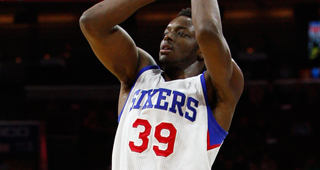The Philadelphia 76ers are a beautiful mess. On Monday, they announced that Jerry Colangelo, longtime director of USA Basketball and former owner of the Phoenix Suns, will lock arms/butt heads with Sam Hinkie, as the newest and most distinguished member of a front office that’s already chest deep in the most sacrificial long-term vision the league’s ever seen.
The hiring signals that The Process will pivot from “intriguing/depressing science experiment” to more traditional means—the days of pretending free agency doesn’t exist might be over.
But until then, the Sixers are stuck with a miserable bag of long-limbed toddlers who weren’t built to harmonize. Each was handpicked for a losing effort. Some are blue-chip prospects who like bar fights and being out of shape. Others are practice squad vagabonds. And then there’s Jerami Grant.
Selected with the 39th pick in the 2014 NBA Draft, Grant embodies non-distilled upside. Is he a real NBA player or a Hinkie placeholder? This question currently lacks a definitive answer, but here’s a look at what we know: Grant is a spastic 6’8”, with shot-deterring tentacles jutted from each shoulder and the necessary combination of girth and speed to defend every position. His father, Harvey, had a nice NBA career, and his uncle, Horace, won three championships with Michael Jordan. There’s real pedigree and eye-popping athleticism.
He’s the type of prospect any smart team would take a flier on with a second-round pick, but only the Sixers would actually play him heavy minutes this early in the game. So far, he’s mostly held his own on both ends, slowly figuring out how he can help by managing his weaknesses and flexing his strengths.
Every so often, hopeful blips of optimism make you think Grant will have a sturdy, if not special NBA experience:

There are diluted shades of a blossoming Andre Iguodala in this sequence, from the disciplined individual takedown of a charging Danilo Gallinari, to the imaginative flip beneath the basket that’s immediately bungled by JaKarr Sampson. It’s 10 seconds of heaven for the Sixers and their suffering fanbase.
But then you measure all the toxicity in Philadelphia’s air and can’t help but wonder what’s real and what’s manufactured? It’s a team of unwilling/unable passers who don’t quite trust each other or themselves. There’s no space, no plan, no semblance of an offensive identity. Philly’s roster is the worst incubator for young talent in the league, which makes you wonder how much Grant’s surroundings are to blame for one of the yuckiest outside shots in the league.
Right now, he’s only shooting 18.4 percent from behind the three-point line (dead last among all players with at least 49 attempts, per Basketball-Reference), with odd form, a slow release and off-balance spring. He’s almost always wide open, too. It’s a weakness that lowers his ceiling and could even shorten his career. Last season, he shot 31.4 percent on even more attempts per 36 minutes. But Grant makes his free throws, and this year he’s done a much better job finishing around the rim. (Over half his shots are in the restricted area.)
Still, offense doesn’t project as his long-term calling card. It’s defense that should already turn heads. The league is overcrowded with superhuman athletes, but Grant’s physical properties stand out. His wingspan, last measured at the 2014 NBA Draft Combine, is about two inches above average for someone his height, and is a big reason why Grant’s far and away the best shot-blocking wing in basketball.
He’s averaging 1.8 blocks per game right now, which is kind of historic. The only active player 6’8” or shorter to top that for an entire season is Gerald Wallace, who averaged 2.1 back in 2006. (The NBA has only seen eight others in its history.) Grant is 13th in block percentage (higher than Dwight Howard, Bismack Biyombo and Tim Duncan) and has more total blocks than Rudy Gobert, Draymond Green and Andre Drummond. He’s doing what those at his position aren’t built for, which is neat, and his timing in the air is tremendous.
This helps Grant stand above the Sixers’ sludge, but not all of his aesthetics are so pleasurable. He has zero plan before taking off on a drive, and nobody’s all that surprised when he air balls a floater from five feet away. But all in all it’s thrilling to watch Grant grow and stumble and soar.
Imagine him starting for the Los Angeles Clippers or New Orleans Pelicans. Is he the next Iguodala or Al-Farouq Aminu? Are the Sixers, in their current state, stunting his growth or giving him wings? What would he look like in a free-flowing atmosphere, with professionals who understand when to pass and how to get open?
The good news is Grant’s effort is the cornerstone of his future. He hustles and tries and has yet to surrender on a team that offers plenty of reasons to do so. If Hinkie’s tenure as an architect is almost over, the good it provided were solid opportunities to pseudo-promising athletes like Grant. Would any other team have really given him a chance? An even more important question: Will it ultimately matter?



